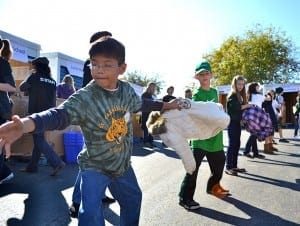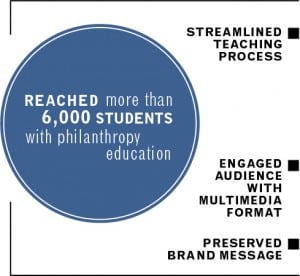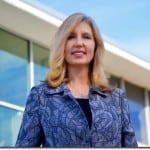In 2011, Texas public schools lost $5.3 billion to massive budget cuts. As a result, schools were forced to cut valuable educational programs. One piece of curriculum in danger of losing its funding was A Legacy of Giving (Legacy), a nonprofit organization that teaches children to be philanthropists.
Seventeen of the schools that partnered with Legacy were Title 1 schools, which not only served a high percentage of students from low-income families, but also suffered some of the most severe budget cuts. Several of the schools had to immediately stop participating in the program, and Legacy was suddenly faced with losing up to 70% of its partnerships.
That’s when PetersGroup Public Relations stepped in. The agency volunteered to help Legacy streamline its costs, which would allow the program to continue running in all its partner schools.
Together with the Legacy board of executives, the PetersGroup came up with the following objective: Identify a cost-effective solution that would help Austin area schools retain the Legacy program for students, and maintain the integrity of the content and curriculum.

GIVING BACK
Linda Brucker, executive director of Legacy, said
that the word “philanthropy” has its roots in the Greek word for “benevolence to mankind.” Nowhere does the definition stipulate that only the likes of Warren Buffet, Bill Gates or Oprah Winfrey need apply. By working with some of the poorest schools in the district, Legacy enables children who have come to see themselves as solely recipients of others’ charity to give back themselves.
To illustrate her point, Brucker explained how a young girl approached her at an early Legacy event. “Excuse me are you Mrs. Brucker?” the girl asked. After introducing herself, the student thanked Brucker for the Legacy program, stating, “My family goes to the food bank to get the food. After doing your program, I realized I could be a giver, too.”
Brucker stressed that after participating in the Legacy program, the student will never be the recipient again. “We gave her permission, because she has talent and makes these great posters, to give back,” she said. “Now, she is the one changing the conversation.
“We live in an incredibly entitled society,” Brucker added. “What people forget to tell you is that you’re entitled to give back. If you don’t have that conversation, then entitlement will continue to rule.”
Legacy is built upon the belief that charity is intrinsic in every child, but our society has lost the ability to have a conversation about how to give. What’s so special about Legacy is that it infuses philanthropic methods into the curriculum of a child’s schoolwork.
The original Legacy program was expensive, because it required the hiring and training of well-qualified education specialists, in addition to the customization of curriculum for each grade level and class subject.
To reduce the cost of providing Legacy’s philanthropy lessons, PetersGroup led the team to create interactive, customized videos suitable for screening at academic assemblies, which integrated with current classroom curriculum for each grade level. However, arriving at that conclusion was no easy task.

Lauren Peters, founder and CEO of PetersGroup, who sits on the Legacy committee, recalled the day the budget cuts were announced.
Sitting in a room with the rest of the board members, she racked her brain for solutions: “What can we come up with to maintain the program and still bring this gift to the students? Will we have to pull the plug?” she said. The brainstorming process was one of the largest creative challenges for Peters.
“When you’re coming up with a creative concept, it can be a challenge for everyone to share the same understanding of what the outcome would be,” she said. “You can present your proposal, and everyone will nod, but ultimately there can be different creative ideas going on internally.”
THE ‘EUREKA’ MOMENT
After the committee agreed upon the video strategy, the next obstacle came during the storyboarding process. Some board members thought there needed to be 12 or 13 different videos, but others saw that several of the themes could be combined, cutting that number in half.
“A hurdle was getting everyone aligned about how we would deliver our message and what the end result would be,” Peters said. Everyone was on the same page with at least one part of the process: The “eureka” moment came when the committee realized how much the cost of Legacy could be reduced by changing the delivery of the program to video.
Pre-budget cuts, the Legacy program was administered by teachers to individual classes. This meant that each teacher needed to be trained by a Legacy-certified educator across 36 schools, upping the cost of the program significantly and making it difficult to ensure continuity in how each teacher rolled it out to their own classrooms.
The videos had a huge reach and encouraged significant engagement and use.
PetersGroup led the overall project management and content strategy for the production of five, 20-minute videos. Employing a multimedia mix of still and full-motion images, “jib-jab” animation, voice-overs, sound effects and onscreen characters, the videos captivated their audience, morphing curriculum into a fun and enriching visual experience.
Throughout the creation process, PetersGroup provided guidance to make sure the videos would be as effective as the more expensive, off-screen curriculum they were replacing and incorporated history and philanthropy lessons in tandem with classroom content.
“Our program employs different educational pedagogies, like social and emotional learning, through media to teach a lesson,” Brucker said. PetersGroup helped Legacy create a five-step process for students eager to become philanthropists:
1. Learn about the concern.
2. Internalize it and find your personal connection.
3. Advocate by adding your voice to that cause.
4. Act to affect change.
5. Reflect and analyze your experience.
PR is all about messaging, and PetersGroup successfully accomplished the objective of any public relations campaign worth its salt: Deliver an effective message in the best, most cost-effective way. “PetersGroup helped us develop that multimedia asset that teaches children about philanthropy and lives outside of a textbook,” Brucker said. “And does it so well that the kids don’t even realize they’re learning.”
‘PR MACHINES’
Based on the content delivery and cost-benefit strategy, Legacy was able to retain every single one of its current schools—and attract seven wait-listed schools. The program adjustments allowed Legacy to streamline teacher resources and cost-effectively reach more than 6,000 students in 33 schools regarding their role as young philanthropists.
“We turn these kids into their own PR machine,” Brucker said. “Because they’re empowered.” PRN
CONTACT:
Lindas Brucker, [email protected]; Lauren Peters, [email protected].
Crafting Budget- Conscious PR Programs
When Texas school district budgets were being slashed and putting the Legacy of Giving philanthropy program at risk in most K-12 classrooms, we needed a solution that made the philanthropy curriculum accessible and affordable without sacrificing quality and student learning.
▶ Don’t forget your audience. The initial idea and solution for the schools was to engage our agency to create a basic PowerPoint highlighting A Legacy of Giving, its value and incorporating some examples of high-profile donors. Considering the attention span of thousands of elementary, middle and high school students, a four-letter word quickly flooded our thoughts: Dull. The solution had to be more creative. While the content needed to be relevant to the curriculum and grade-appropriate, it had to be interesting with enough interaction and creative visuals to engage people.
▶ Identify what works—and doesn’t—about an idea. Apart from the dull factor, the delivery of a PowerPoint was on point, so we expanded on the presentation concept and moved to a multi-media format. An interactive presentation was designed to wrap around 12-plus video modules. The “wrapper,” as we dubbed it, set the context around world issues and explained what philanthropy means and how each student can give their time, talent or treasure.
▶ Celebrate your wins. This project stretched our team to truly think beyond traditional PR solutions and design something unique and historically accurate. We were successful in packaging almost 20 learning modules and happened to brush up on our history along the way.
This article appeared in the September 23 issue of PR News. Subscribe to PR News today to receive weekly comprehensive coverage of the most fundamental PR topics from visual storytelling to crisis management to media training.

